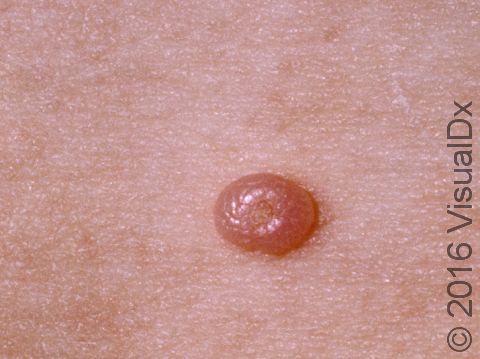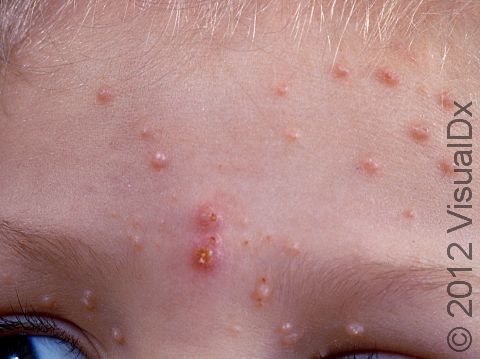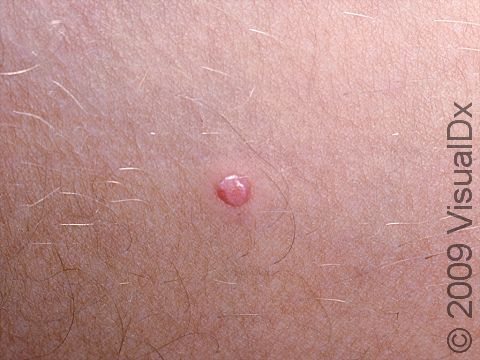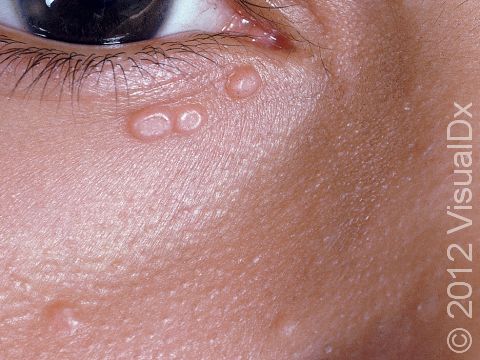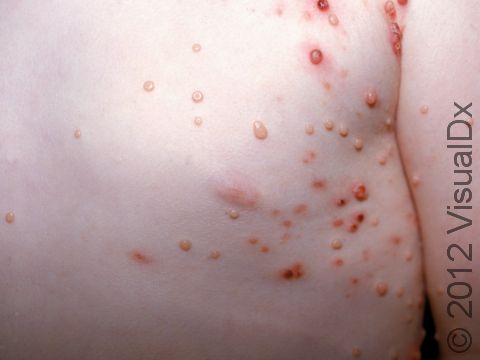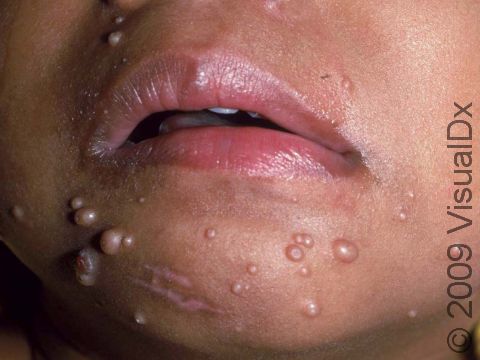Molluscum Contagiosum (Pediatric)
Molluscum contagiosum is a common viral infection of the skin that resolves on its own, usually within a few months. It can spread to other areas of the skin by scratching or rubbing (self-inoculation) and can be transmitted to other people by skin-to-skin contact or handling contaminated objects such as towels, toys, and clothing. Poor hygiene and warm, moist climates encourage the spread of molluscum contagiosum. Use of public swimming pools is a common source of childhood infections.
Who's At Risk?
Children aged 2-5 years are most commonly affected with molluscum contagiosum, but it can occur in any age. Molluscum contagiosum is rare in children aged younger than one year. Children with atopic dermatitis (eczema) may more commonly be affected by molluscum contagiosum.
Signs & Symptoms
One or more small (1-6 mm) pink, skin-colored, or pearly papules (solid bumps), often with a tiny dimple in the center, occur in clusters and sometimes in a straight line in molluscum contagiosum. In darker skin colors, the molluscum contagiosum lesions may appear skin-colored or purplish. The bumps are usually painless and may occasionally itch. Individual lesions may get bigger over the course of 6-12 weeks. In patients with a weak immune system, they can be larger than a thumbnail.
Infections may be:
- Mild – fewer than 10 lesions.
- Moderate – between 10-50 lesions.
- Severe – more than 50 lesions.
Common areas for molluscum contagiosum lesions are the chest, abdomen, back, underarms, groin, or backs of the knees. Occasionally, they can be seen on the face and genital region.
Because the incubation period for molluscum contagiosum is 2 weeks to 6 months, lesions may not be seen immediately after contracting the virus. Molluscum contagiosum infection is self-limited, meaning lesions will go away on their own. This typically takes 6-9 months, but lesions sometimes last a few years. As the lesions begin to resolve, they may initially appear more inflamed, with pus and crusting, before they eventually fade. They usually do not leave a scar.
Self-Care Guidelines
Treatment of mild molluscum contagiosum infections is often not required because lesions will eventually resolve on their own. However, your child can decrease the chance of spreading the infection to other parts of their body or to other people by following these guidelines:
- Do not scratch the affected areas.
- Avoid sharing clothing, towels, bedding, and other personal care items with others.
- Keep the affected areas covered, if possible.
Treatments
Your child’s health professional will most likely be able to diagnose molluscum contagiosum by its appearance.
Again, this viral infection will resolve on its own within a few months. Talk to your child’s health professional about whether they recommend treatment or watchful waiting. No treatment is 100% effective, and most have potential side effects such as pain or irritation of the skin.
Possible treatments include the following:
- Application of medications in office that cause a blistering reaction
- Topical berdazimer gel
- Tretinoin (Retin-A)
- Imiquimod cream (Aldara, Zyclara) may be useful for widespread, difficult-to-treat lesions
- Removal with freezing (cryosurgery), scraping (curettage), or burning (electrocautery). All of these options may be painful.
Visit Urgency
See your child’s health professional if the molluscum contagiosum infection is moderate or severe or if you are concerned about spread of infection or its appearance. Also see your child’s health professional for any molluscum lesions on their genital or anal regions.
References
Bolognia J, Schaffer JV, Cerroni L. Dermatology. 4th ed. Philadelphia, PA: Elsevier; 2018.
James WD, Elston D, Treat JR, Rosenbach MA. Andrew’s Diseases of the Skin. 13th ed. Philadelphia, PA: Elsevier; 2019.
Kang S, Amagai M, Bruckner AL, et al. Fitzpatrick’s Dermatology. 9th ed. New York, NY: McGraw-Hill Education; 2019.
Paller A, Mancini A. Paller and Mancini: Hurwitz Clinical Pediatric Dermatology. 6th ed. St. Louis, MO: Elsevier; 2022.
Last modified on January 12th, 2024 at 10:55 am

Not sure what to look for?
Try our new Rash and Skin Condition Finder
